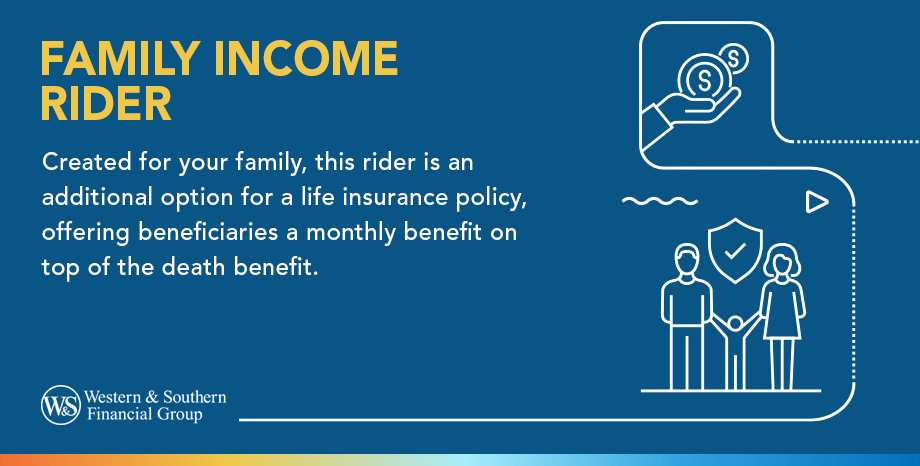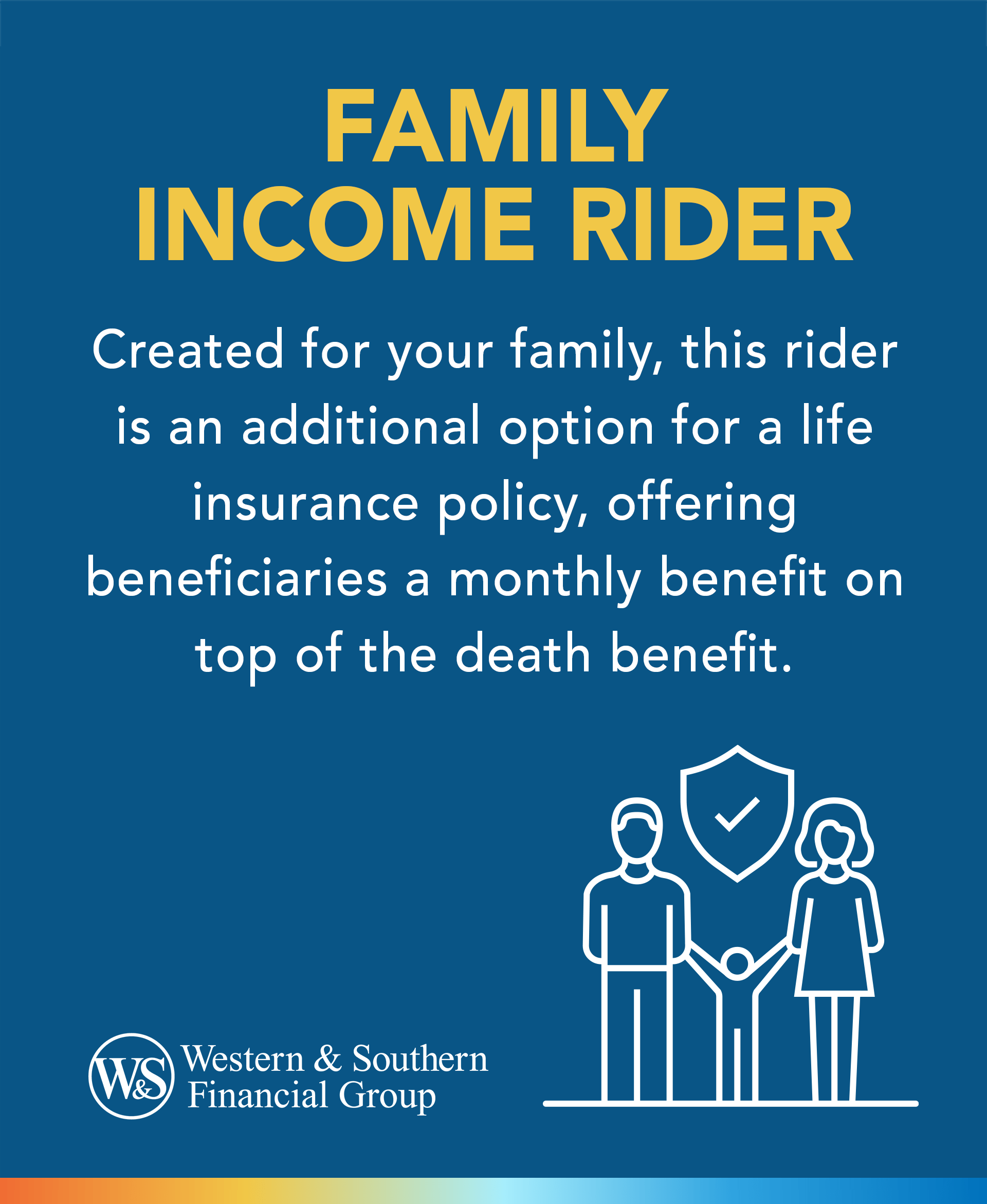Table of Contents
Table of Contents


Key Takeaways
- A family income rider provides a regular monthly income to beneficiaries on top of the base death benefit.
- The rider is designed to replace lost earnings and ensure a steady income for dependents.
- Adding a family income rider to your life insurance policy can increase the cost of premiums.
- The benefits of this rider depend on individual circumstances and financial needs.
- The family income rider may not be necessary for those with substantial life insurance coverage and savings.
What Is a Family Income rider?
A family income rider (also known as a family income benefit rider) is an additional provision that can be added to a life insurance policy to provide your beneficiaries a regular monthly income, typically for a predetermined period following your death.
It is designed to supplement the lump sum death benefit provided by most life insurance policies and replace lost earnings, ensuring your family receives a steady income even if you're no longer around.
Family income riders may be added to term life insurance policies and permanent life insurance policies such as whole life insurance or universal life insurance, depending upon the insurance company.
How Does a Family Income Rider Work?
A family income rider works as an add-on to your base life insurance policy. Here's a step-by-step explanation of how it typically works:
- Selection: When you purchase your life insurance policy, you choose to add the family income rider. At this time, you'll also select the monthly income amount that the rider will provide to your beneficiaries, as well as the duration of the payments. This is often structured to continue until a specific event, such as when your youngest child reaches a certain age.
- Premium Payments: The cost of the rider is added to the premiums of your main life insurance policy. This cost is influenced by your age, health, the monthly income you want your beneficiaries to receive, and the length of time those benefits should be paid.
- Claim: If you, as the insured, pass away during the term of the policy, your beneficiaries can file a claim with your insurance company.
- Payout: Once the claim is approved, in addition to the base policy lump sum death benefit, your beneficiaries will start receiving a monthly income as specified by the rider. This income will continue for the duration specified in the rider, whether it's a certain number of years or until an event such as your youngest child reaches adulthood.
- End of Payments: When the specified term is over, the monthly payments stop, but the beneficiaries typically keep any remaining death benefit from the base policy.
This rider can provide an additional layer of security for families, as it can help replace lost income and maintain the family's standard of living in the event of the insured's death.
It's important to note that the specifics of these insurance riders can vary widely depending on the insurance company and the specific policy terms and conditions. Always review the policy's details and consult with an insurance professional to fully understand the benefits, limitations, and costs.
Who Is Eligible for a Family Income Rider?
Eligibility for a family income rider generally depends on several factors, typically evaluated at the time of policy purchase. Here are some common criteria:
- Policyholder Status: You must first be eligible for and hold a life insurance policy with the insurer. The family income rider is an add-on or "rider" to a base life insurance policy.
- Age: Insurers often have age restrictions for adding a family income rider. The specific age limit can vary among insurance companies, but commonly, the policyholder must be under a certain age, such as 60 or 65, when the policy is issued.
- Health Status: As with most life insurance products, your health status at the time of application can affect eligibility. If you have certain pre-existing health conditions, you may be ineligible for a family income rider, or it may cost more.
- Financial Need: While not necessarily a strict eligibility requirement, a family income rider is generally most suitable for those with dependents who would need to replace the insured's income in the event of their death. If you have no dependents or your dependents have sufficient income or resources of their own, this type of rider may not be necessary.
What Are the Benefits of a Family Income Rider?
A family income rider offers several benefits, which include:
- Income Replacement: One of the main advantages of this rider is the provision of regular, ongoing income to your beneficiaries after your death. This can be particularly valuable for families where the insured is the primary income earner.
- Financial Security: The consistent income can help maintain the family's standard of living and cover daily expenses, as well as larger expenses such as mortgage payments or children's education costs.
- Flexibility: The payout from a family income rider is typically not restricted to specific uses, which allows your beneficiaries the flexibility to use the money as they see fit.
- Budgeting Ease: Regular monthly payments can be easier to manage and budget than a single lump-sum payout.
- Protection for Dependents: The income can continue until a specific milestone is reached, such as when a child reaches adulthood or finishes their education, providing financial security during their dependent years.
- Added Serenity: Knowing that your family will have a steady stream of income if something were to happen to you can provide significant peace of mind.
These are the general benefits, but each person's situation is unique, so the benefits will depend on individual circumstances and needs.
Extend your coverage to provide continuous family income support. Get a Free Life Insurance Quote
Potential Drawbacks of the Family Income Rider
While a family income rider can offer valuable benefits, there are also some potential drawbacks to consider:
- Additional Cost: Adding a family income rider to your life insurance policy increases the cost of your premiums. Depending on your financial situation and the specifics of the rider, this increased cost may or may not be worth the potential benefit.
- Fixed Payouts: The monthly income from a family income rider is typically fixed at the time of policy purchase and does not adjust for inflation. This means the real value of the payouts could diminish over time, potentially leaving your beneficiaries with less purchasing power in the future.
- Limited Availability: Not all life insurance policies offer family income riders and eligibility for these riders can be limited based on factors such as your age, health, and the specifics of your base policy.
- Potential for Over-insurance: If you already have sufficient coverage to help protect your family's financial needs, adding a family income rider could lead to unnecessary costs.
- Loss of Lump Sum: The monthly income may not be as beneficial in certain scenarios, like if your family needs a large lump sum for immediate expenses after your death.
- Duration of Benefits: If the insured lives past the period specified in the rider, no benefits will be paid out, despite the additional premiums paid over the years.
As with all insurance decisions, it's important to weigh these potential drawbacks against the benefits to determine if a family income rider is a good fit for your needs.
How Much Does a Family Income Rider Cost?
The cost of a family income rider varies greatly depending on several factors:
Policyholder's Age and Health: Older policyholders and those with certain health conditions typically pay higher premiums.
Income Benefit Amount: The higher the monthly income you want to provide for your beneficiaries, the higher the cost of the rider.
Duration of Income: The longer the period of time you want the income payments to continue, the more the rider will cost. For example, a rider designed to pay out for 20 years will cost more than one designed to pay out for 10 years.
Base Policy Amount: In some cases, the cost of the rider may be related to the amount of the base policy. A larger base policy may lead to a higher cost for the rider.
Insurance Company: Each insurance company has its own method of calculating premiums, so costs can vary from one insurer to another.
It's important to note that a family income rider is an optional add-on to a life insurance policy and will increase the total cost of your insurance coverage. As such, it's crucial to balance the need for the added protection it provides with the additional cost.
Is the Family Income Rider Right for You?
Whether a family income rider is worth it or not depends largely on your individual circumstances, financial needs, and goals. Here are a few factors to consider:
Financial Dependents: If you have dependents who rely on your income, a family income rider can provide them with regular, ongoing income in the event of your death, helping to maintain their standard of living. This can be particularly beneficial for families with young children or other dependents who would need financial support for many years.
Existing Coverage: If you already have substantial life insurance coverage and savings that would adequately support your dependents, a family income rider may not be necessary.
Cost vs. Benefit: Consider the cost of the rider in relation to the benefit it provides. If the additional monthly premium amount is manageable and the potential benefit is significant, it might be worth the cost.
Future Needs: The income provided and monthly payment made by this rider is often fixed and does not adjust for inflation. If you're concerned about keeping pace with rising costs in the future, you may want to explore other options.
Before making a decision, it's recommended to discuss your individual circumstances with a financial advisor or insurance professional. They can provide personalized advice based on your specific needs and financial situation.
Keep in mind that there are various types of life insurance policies and optional life insurance riders that may be suitable for your needs. It is important to take the time to thoroughly research buying life insurance and consider all available options, taking into account your financial objectives, family, and personal preferences.
A family income rider can help financially support during tough times. Get a Free Life Insurance Quote
Frequently Asked Questions
Can I make changes to a family income rider after obtaining my policy?
While it's not always possible to alter a family income rider once your policy is in place, some insurance companies might offer flexibility under certain conditions. You should keep in mind that changes could potentially affect your monthly premiums or the benefits provided by the rider.
Before making any adjustments, you're encouraged to reach out to your insurer and discuss the potential implications.
What is the difference between a family income rider and a decreasing term life insurance policy?
A family income rider on a life insurance policy provides an additional monthly payout to your beneficiaries upon your passing until the end of the rider term, supplementing their financial needs.
A decreasing term life insurance policy is designed with a death benefit that decreases over time as you pay off debts or loans. Essentially, it's about safeguarding against lingering debt rather than ensuring ongoing income for loved ones.
Is a family income benefit taxable income?
The answer is generally no. Family income death benefits are not typically viewed as taxable income by the Internal Revenue Service (IRS)1. This means that if you're a beneficiary receiving this type of payout due to a loved one's unfortunate accident, it won't increase your annual income for taxation purposes. However, any interest earned on these sums can be subject to taxes.
As with all financial matters, it's wise to consult with a tax advisor or financial advisor who can give personalized advice based on your specific circumstances.
Sources
- Life Insurance & Disability Insurance Proceeds. https://www.irs.gov/faqs/interest-dividends-other-types-of-income/life-insurance-disability-insurance-proceeds














